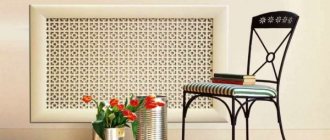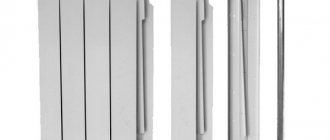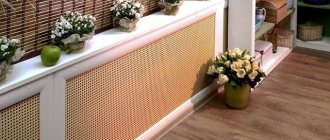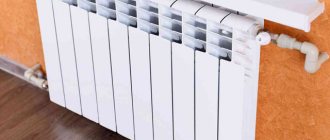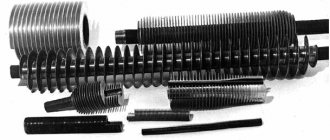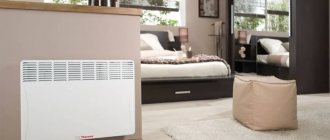When decorating residential premises, special attention is paid to design. Property owners strive to get away from stereotypes that have been developed over the years and use every opportunity to create an exclusive interior.
A stylish decorative screen for a heating radiator will radically transform its appearance and hide all visible imperfections.
In this material we will talk about the types of decorative grilles for batteries, and also give some tips on choosing this decorative element.
Functions of the radiator grille
In addition to the design characteristics, which are clearly visible in the photo of radiator grilles, these items also perform other functions, such as:
- Protection against battery damage;
- Aesthetics;
- Limiting access to hot heating elements (this is especially important for rooms where children are).
Advantages
The designs have many advantages, including:
- Do not block free air circulation;
- Prevents dust accumulation;
- Allows you to complement the design in the appropriate style;
- Products made of thermally conductive material can increase heat transfer;
- Do not allow injuries from sharp or hot elements of the heating system;
- Easy to care for;
- Perfectly hide the unsightly appearance of outdated battery models;
- Acceptable price.
Flaws
Cons often relate to the material rather than the product itself. Therefore, before making a purchase, you need to study the design flaws.
- Plastic surfaces of products are often subject to deformation due to mechanical stress or temperature conditions. Ultraviolet light can cause the grille to change color. Plastic is not an environmentally friendly material, so at elevated temperatures it releases toxic substances and an unpleasant, pungent odor. Static characteristics also leave much to be desired.
- The metal grille on the heating radiator is dangerous due to its sharp parts, so it is not recommended to purchase structures made from such material or choose models with perfect processing. Also, metal products are difficult to fit to existing radiators.
There are models with incorrect location and size of ventilation holes, which makes the functionality of the product and heating system ineffective.
Option number 2: Practical drywall
The second most popular material for decorative screens is plasterboard. It is easy to process, is not afraid of heat and is relatively cheap.
To build a grille, you first need to take measurements and perform simple markings: on each side of the heating radiator, draw lines for mounting the box with an indentation of 7 cm. Then cut out the frame strips from the metal profile - their width should be at least 5-6 cm. You will need 5 profile elements: two side, top and two protruding. Moreover, the latter need to be made the longest - to create the depth of the box, they will have to be bent twice.
Scheme: plasterboard box
When the planks are ready, use self-tapping screws to secure them to the previously marked lines: first the top, then the side ones. Next, carefully bend the long guides at an angle of 90 degrees twice: you should get U-shaped parts. Then use self-tapping screws to fix their edges to the side planks to form a prototype of a protruding box.
Now all that remains is to cut out the panels from the plasterboard for covering the body and fasten them to the profile with screws. Don't forget to make holes in the front and top of the screen.
Criterias of choice
There are many retail outlets where it is not difficult to buy radiator grilles, but when choosing, you should rely on certain criteria.
- Attractive appearance without loss of functionality.
- Free access for wet cleaning.
- Fastening strength.
- Safety during operation, which depends on the configuration and processing of the protective screen.
- The design should not interfere with the heat exchange process.
- Price for radiator grilles.
Purpose
Decorative screens for the heating system help give your room a more complete look. When carrying out renovations, few people think about how the heating system will fit into the new renovation. Only after the renovation is completed does it become clear that something needs to be done with the heating system.
If you have a new apartment, then the batteries can look quite respectable and fit into the existing design.
But what to do if the house is old and the heating system is old. In this case, you will undoubtedly be helped by screens that can hide your cast-iron radiator, and the heating system will be in harmony with your renovation.
Kinds
Battery sheathings are made in several types:
- Flat, designed for installation in niches.
- Wall mounted ones without a cover hide batteries that do not protrude beyond the edge of the window sill.
- Wall-mounted ones, which have a removable lid on top, are used for radiators that protrude beyond the window sill.
Frame, which is a box that completely hides the placement of the radiator.
Materials
It is rare that repairs these days can be completed without lining heating radiators with decorative structures. They can be made from various materials and have different configurations, textures and colors.
Most often, gratings are made from:
- Natural wood;
- Plastic;
- Metal;
- MDF;
- Plexiglas.
Features of use
Considering the characteristics of the products and their installation locations, it is worth following some recommendations.
- It is advisable to trim the wall behind the heating source with foil, this will make heat transfer more efficient.
- It is desirable that the structure can be easily and quickly dismantled for easy access for maintenance and repair work if necessary. This is also important to avoid damage to the product and fasteners.
- In rooms it is better to install structures made from natural raw materials, for example, wooden grilles on heating radiators.
- The distance between the grille and the elements of the heating system must be more than 30mm.
- Do not block the radiator lining with furniture or other objects. As a last resort, you can install products specifically designed for installation to the battery and having ventilation passages.
It is prohibited to use the product for purposes other than its intended purpose, for example, for drying clothes.
Available types of screens
Consumers are offered a wide selection of decorative grilles for batteries, which differ in size, shape, design, material of manufacture and other characteristics.
When choosing the best option, you must be guided by the task assigned to the equipment, the characteristics of the room and the personal preferences of the owner.
There are 3 main types of radiator screens:
- Hanging structures . Models of this type are used to hide old cast iron batteries that resemble an accordion. These simple decorative designs can have 1 or more sections, with or without a top cover. They are attached with hooks or placed on the fins of heating equipment.
- Flat designs. They are also called façade and are used for radiators located in niches. The products have the form of a rectangular frame, inside of which there is a sheathing. They are mounted overlapping on the wall niche so that the radiator does not protrude beyond its boundaries.
- Protective boxes. This is the best option for hiding heating devices located along the wall of the room. Screens of this type are the most difficult to manufacture and install. The protective box completely covers old radiators and looks great in any interior. The disadvantage of the product is that part of the heat remains inside it, and only 40-50% enters the room.
Radiator screens can be mobile or stationary. The installation method is selected depending on how the batteries are installed in the room. The main thing is that the structure can be easily removed.
Even a simple screen on the heating radiator improves the distribution of hot flows. To increase the convection of hot air, the design of most models has perforations
Manufacturing
You can make a battery grid yourself, following the step-by-step instructions.
- First you need to make markings. To do this, you need to take the battery parameters as a basis, add 50mm to the height, and 100mm to the width. This will give you the dimensions of the front panel, which can be made from metal mesh.
- The sides can be made from MDF. They will be the same in height as the front part, and the depth is equal to the thickness of the battery plus 30-35mm.
- The lid can be marked according to the obtained parameters for the width and depth of the product, but it is better to make it with 15mm protrusions on each side.
- Cut out all the parts according to the markings and smooth their edges.
- Treat the wooden blocks with an antiseptic, prime them and build a frame from them.
- Cover the front and sides of the frame with prepared parts using self-tapping screws.
- Attach the cover to the rear upper beam using a piano hinge.
- Paint the resulting structure in the desired color or varnish it.
- Cover the wall behind the battery with foil and install the product.
- For greater stability, the grille can be fixed using brackets or suitable fasteners.
- Screw the adjustable feet from the bottom.
The decorative protective radiator trim is ready!
Having received the above information, you can take a more rational approach to choosing a protective grille model suitable for a particular interior. A decorative product will help disguise the unaesthetic appearance of the battery, protect the radiator from all kinds of contaminants, and relieve parents from constant supervision of children.
How to install correctly
The grilles should be installed so that future operation of the radiator and pipes does not cause difficulties. Parts must be cleaned of dirt at least once a year, so access to them is necessary.
Sometimes emergency situations occur in which an immediate response is necessary, and unscrewing fasteners can take up valuable time. In this regard, it would be advisable to consider a fastening system that allows you to remove the radiator protection with one movement.
What fasteners will you need?
The simplest in this matter are hinged and attached screens - they can be removed or moved aside. Flat ones attached to the wall are the most problematic. However, using a couple of strips, you can fix the box on the wall. In this case, the planks must have a beveled top edge.
In addition, you can use metal plates or magnets. Instead of a wooden plank, you can fix a metal corner in the wall. For flat screens, you need to use magnets, plates or hinges with hooks. Sometimes such screens are made in the form of sliding doors.
Installation
Knowing how the battery works, you can personally build a structure that improves heat transfer. It is recommended to use metal for this. However, to work with it, you need a large number of tools and skills.
You can build a grid either from a mesh or from a fiberboard (chipboard). The product will resemble a box on legs, with a lid located at the bottom and top. The facade with the sides is assembled from the frames. The mesh, which is located inside the wooden frame, will ensure good air flow.
Stages of work:
- Prepare the blanks. Knowing the dimensions of the battery, for air exchange you need to add three to eight centimeters on both sides.
- The joints of the parts should be sanded.
- Cut the mesh to the size of the radiator.
- Fasten the frame to the mesh and sides.
- Using corners and self-tapping screws, build a box.
- For better heat transfer, a metal sheet should be mounted at the back.
- The legs are attached to the bottom of the box.
- Install the manufactured box to the radiator using corners and self-tapping screws, fixing it in the wall on each side.
- Elements can be painted or decorated with self-adhesive.

